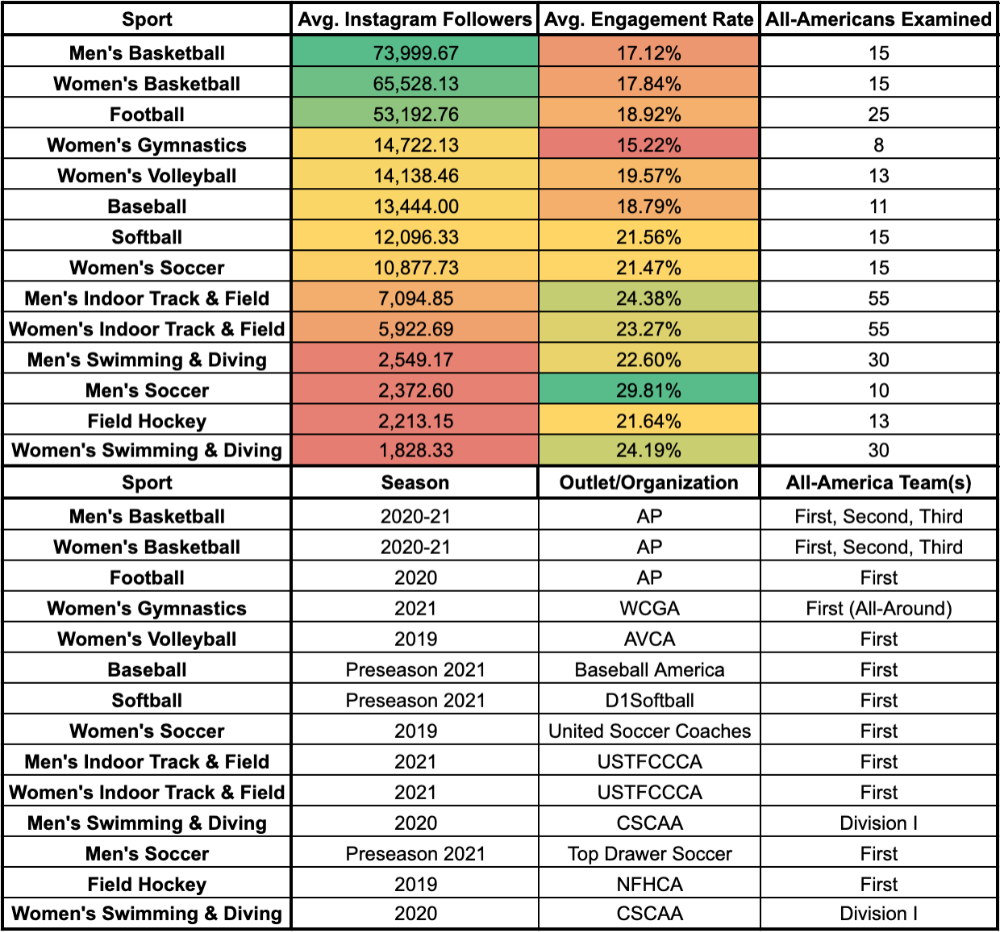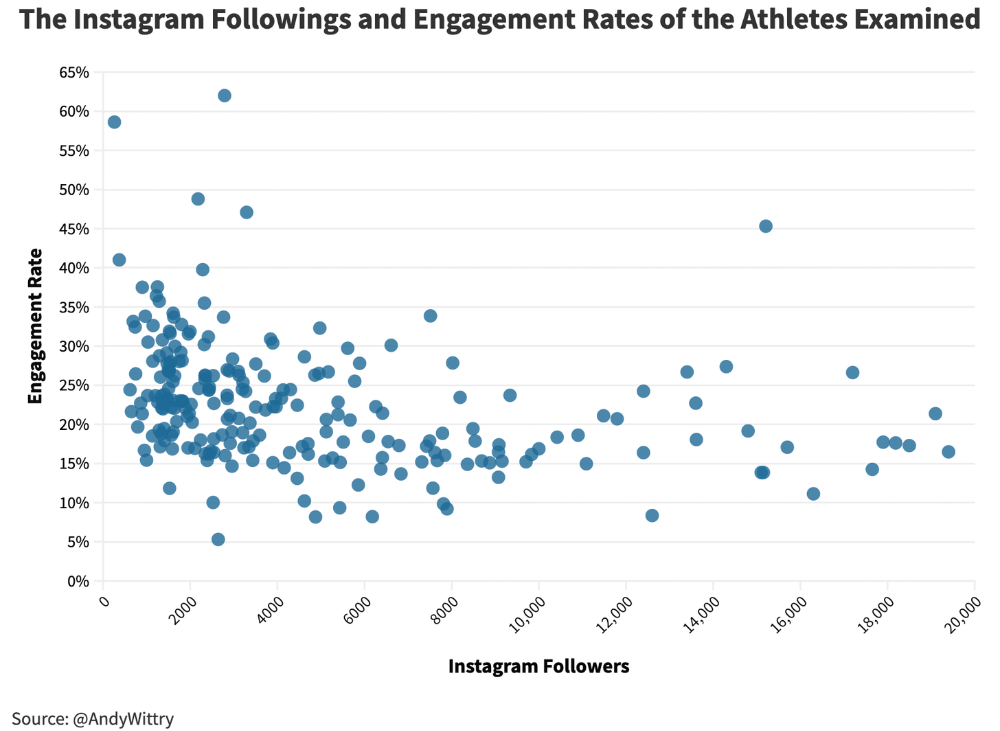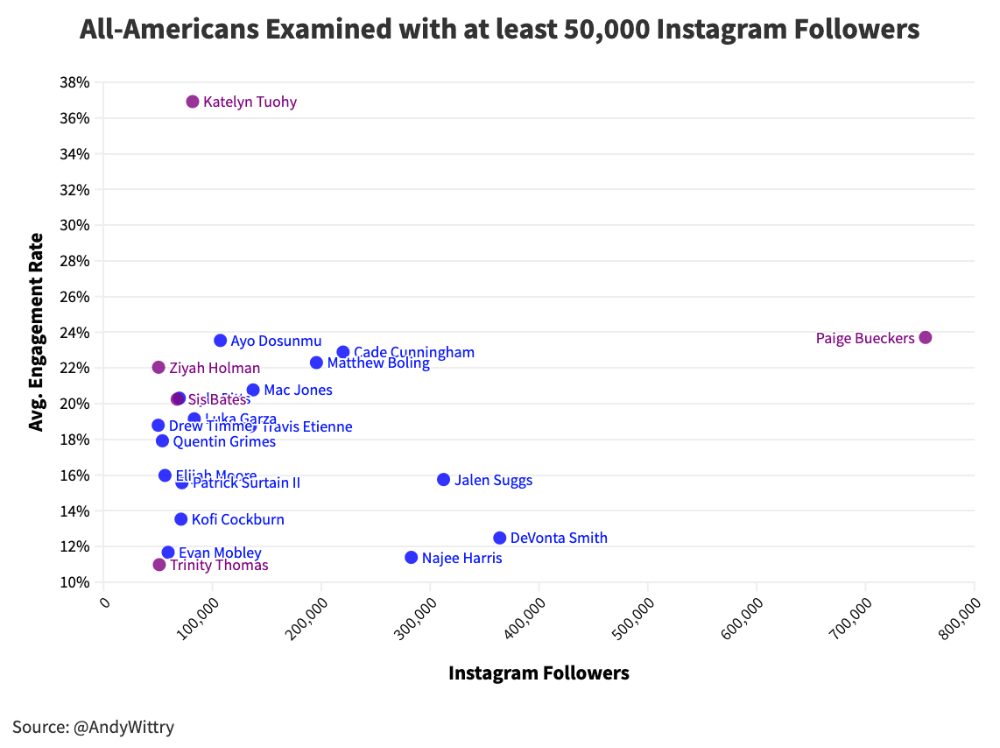Women’s basketball starters whose teams competed in the second weekend of this year’s NCAA tournament have an average of nearly twice as many Instagram followers as their male counterparts, with nine of the 11 starters in the Sweet 16 with the largest Instagram followings being women. If allowed to monetize their names, images and likenesses (NILs), those athletes could capitalize upon annual earning potentials of at least $50,000, if not potential revenue that would be in the mid-to-high six figures for the most marketable college athletes.
This week’s newsletter takes another original deep dive into how the social media followings and engagement rates of some of the top performers in college athletics compare across numerous sports by analyzing the Instagram profiles of athletes who were named to the most recent All-America teams in 14 sports. The Instagram follower and engagement rate data is current as of this week, with the data for men’s and women’s basketball All-Americans being current as of the morning of April 1.
While this analysis doesn’t include every athlete in every sport, or even every All-American, it examines the Instagram followings of many of the highest-performing college athletes and measures them against their peers in other sports.
Being an All-American, or even a starter, isn’t a requirement for a college athlete to build a significant social media following but this study is intended to analyze the Instagram profiles of the athletes who are the very best in their respective sports, and as a result, help identify who could have the greatest earning potential.
First, here are some of the main takeaways:
-
- Given the relatively small sample sizes of most All-America teams, almost every sport has at least one outlier who has an extremely large social media following compared to his or her peers. Sport-wide averages are admittedly an imperfect measure, but given that there are five AP first-team All-Americans in basketball and 25 first-team All-Americans in football, raw totals wouldn’t tell the whole story, either.
-
- For example, with Gonzaga’s Jalen Suggs (312,351 Instagram followers), the men’s basketball first, second and third-team AP All-Americans have an average of roughly 74,000 Instagram followers. Without him, the other 14 All-Americans have an average of roughly 57,000. With UConn’s Paige Bueckers (755,076 followers), the AP’s women’s basketball All-Americans have an average of roughly 65,500 followers. Setting Bueckers aside, the other 14 All-Americans have an average of roughly 16,200 followers. (Even if Bueckers admittedly skews the women’s basketball data significantly, you could argue she’s a data point that can’t be ignored, especially when attempting to measure the audience for women’s basketball using non-traditional metrics. At the very least, Bueckers shows the potential reach and earning potential within women’s basketball.) With Alabama’s Heisman Trophy-winning wide receiver DeVonta Smith (364,000 followers), the 25 AP first-team All-Americans have an average of roughly 53,200 followers, compared to roughly 40,200 without him.
-
- While acknowledging the caveats above, it might come as a surprise that first-team All-Americans in college football do not rank first in terms of average Instagram followers among the 14 sports examined and they rank 10th in average engagement rate.
-
- Alabama’s trio of Smith, quarterback Mac Jones and running back Najee Harris combine for more than 780,000 of the roughly 1.3 million combined Instagram followers (or almost 60 percent) among the 25 players who were named first-team All-Americans by The Associated Press last season. For perspective, Bueckers and Louisville’s Hailey Van Lith – the top two athletes in terms of Instagram followers in last week’s study – have more than 1.4 million followers combined. If you include the Crimson Tide’s first-team All-America offensive linemen Alex Leatherwood and Landon Dickerson, plus first-team cornerback Patrick Surtain II, then the six players from the reigning national champion have roughly 890,00 of the 1.3 million combined followers among AP first-team All-Americans, which means the other 19 athletes have an average of roughly 24,000 followers – a figure that wouldn’t even rank among the 30 largest Instagram followings among the men’s and women’s basketball starters in the Sweet 16. Not every star football player has a six-figure Instagram following and some don’t even have a five-figure follower count.
- Nine of the 25 college football players, or 36 percent, who were named AP first-team All-Americans in 2020 have less than 10,000 Instagram followers, which puts their followings somewhere on the spectrum of the average track and field, swimming and diving, men’s soccer or field hockey All-Americans. For the sake of comparison, five of the AP’s 15 first, second or third-team All-Americans in women’s basketball have fewer than 10,000 followers. Loyola Chicago’s Cameron Krutwig is the only men’s basketball All-American with less than 10,000 followers.
-
-
- All-Americans who compete in Olympic sports or for athletic programs that are labeled as “non-revenue” often have a higher average engagement rate on Instagram than football, basketball and baseball players. While acknowledging that engagement rates often decrease as follower counts increase, there can still be value in third-party sponsorships with these athletes who have fewer followers but higher engagement rates, almost as “micro-influencers” who could potentially provide a higher rate of return at a lower cost for brands and companies.
- Anecdotally, All-Americans who compete in field hockey or swimming and diving appear to be the sports in which All-Americans most frequently have their Instagram accounts set to private. You can read more about athletic program policies that tell athletes to keep their accounts on private – and the policies that do the opposite – and how that can impact future earning potential.
-
Below is the complete table that lists the results of this analysis, with the average number of Instagram followers and the engagement rates for All-Americans in each sport. Since there are a greater number of All-Americans in swimming and diving, and track and field, given the number of events in each sport, a greater number of All-Americans in those sports were analyzed. Due to the quantity of All-Americans in those sports, not every All-American was examined.
Engagement rate measures the sum of likes and comments on a user’s Instagram posts, divided by total followers. We calculated the average engagement rate for each All-American by averaging the engagement rates provided by three different platforms that provide social media analytics. A sport-wide average was calculated by averaging the aggregate averages of the All-Americans examined in each sport.
For private accounts, follower counts were included in the analysis but engagement rates were not.

Among the college athletes examined, who were enrolled in school this academic year and who were named to an All-America team, as defined above, here are the 39 athletes who have at least 20,000 Instagram followers, showing the diversity of sports among All-Americans with the largest social media followings. Once again, not every swimming and diving, or track and field All-American was analyzed.
- 🀠Paige Bueckers, UConn: 755,076 followers
- 🈠DeVonta Smith, Alabama: 364,000 followers
- 🀠Jalen Suggs, Gonzaga: 312,351 followers
- 🈠Najee Harris, Alabama: 282,700 followers
- 🀠Cade Cunningham, Oklahoma State: 220,075 followers
- 👟 Matthew Boling, Georgia: 195,550 followers
- 🈠Mac Jones, Alabama: 137,400 followers
- 🈠Travis Etienne, Clemson: 134,800 followers
- 🀠Ayo Dosunmu, Illinois: 107,308 followers
- 🀠Luka Garza, Iowa: 83,346 followers
- 👟 Katelyn Tuohy, NC State: 81,800 followers
- 🈠Patrick Surtain II, Alabama: 72,000 followers
- 🀠Kofi Cockburn, Illinois: 71,167 followers
- 🈠Kyle Pitts, Florida: 69,600 followers
- 🥎 Sis Bates, Washington: 67,600 followers
- âš¾ Kumar Rocker, Vanderbilt: 64,600 followers
- 🀠Evan Mobley, USC: 59,319 followers
- 🈠Elijah Moore, Ole Miss: 56,400 followers
- 🀠Quentin Grimes, Houston: 54,030 followers
- ðŸ¤¸â™€ï¸ Trinity Thomas, Florida: 51,200 followers
- 👟 Ziyah Holman, Michigan: 50,521 followers
- 🀠Drew Timme, Gonzaga: 50,195 followers
- 🀠Caitlin Clark, Iowa: 43,767 followers
- 🈠Shaun Wade, Ohio State: 41,200 followers
- 🀠Chelsea Dungee, Arkansas: 38,268 followers
- âš¾ Jack Leiter, Vanderbilt: 36,700 followers
- 🥎 Rachel Garcia, UCLA: 36,500 followers
- 🀠Hunter Dickinson, Michigan: 34,195 followers
- 🀠Dana Evans, Louisville: 28,002 followers
- 🀠Corey Kispert, Gonzaga: 27,961 followers
- ðŸ¤¸â™€ï¸ Maile O’Keefe, Utah: 27,700 followers
- 🀠Aaliyah Boston, South Carolina: 26,963 followers
- 🊠Santiago Grassi, Auburn: 26,228 followers
- 🀠Jared Butler, Baylor: 25,457 followers
- ðŸ Dana Rettke, Wisconsin: 24,800 followers
- 🀠Herb Jones, Alabama: 23,358 followers
- 👟 Cooper Teare, Oregon: 23,117 followers
- 👟 Anna Hall, Georgia: 22,200 followers
- 🈠Landon Dickerson, Alabama: 21,100 followers
“Sports that you may not traditionally or typically associate with having the same sort of commercial reach or pedigree as football or basketball actually could turn out to be very, very successful in whatever the new landscape ultimately looks like,” said Darryl Seibel, a founding partner of Stadion Sports, which provides advice and an education-based approach to NIL for its clients and partners. “The fan following is significant, it’s informed, it’s engaged and that represents real opportunities, so again, sports that you might not automatically or immediately associate with strong NIL opportunities could in fact do very, very well.”
Below is a scatter plot with the same data that’s in the table above, showing how All-Americans who compete in Olympic or “non-revenue” sports – and especially women – often have some of the highest average engagement rates of All-Americans in any sport.

Engagement rates can be difficult to maintain as one’s social media following climbs into the hundreds of thousands (see: Alabama running back Najee Harris with 284,000-plus followers on Instagram but an engagement rate just over 11 percent), which could provide an additional incentive for companies to purse third-party sponsorships with athletes who have a large social media following and a fairly high engagement rate.
Here are several examples of 2021 All-Americans or preseason All-Americans who fit that mold:
- Paige Bueckers, UConn: 755,076 followers | 23.7 percent
- Cade Cunningham, Oklahoma State: 220,075 followers | 22.9 percent
- Matthew Boling, Georgia: 195,550 followers | 21.5 percent
- Ayo Dosunmu, Illinois: 107,308 followers | 23.5 percent
- Katelyn Tuohy, NC State: 81,832 followers | 36.9 percent
- Sis Bates, Washington: 67,626 followers | 20.6 percent
- Ziyah Holman, Michigan: 50,509 followers | 22.0 percent
Boling, the track and field sensation who was featured on ESPN programming as a high schooler, is a great example of the type of Olympic-sport athlete who could stand to benefit more than most athletes from NIL legislation, similar to Tuohy (more on her in a second) and Holman (grab some popcorn and watch the video below). Boling, who earned a national-best three first-team All-America indoor track and field honors from the USTFCCCA in March, has an Instagram following and engagement numbers that are similar to those of Oklahoma State’s Cade Cunningham, who’s projected to be drafted No. 1 overall in the 2021 NBA Draft.
On the other end of the spectrum, athletes with smaller, but more engaged social media followings could potentially provide value for localized or hyper-targeted marketing campaigns if an athlete’s followers are more likely to engage with his or her posts, based on the sport or the school, or the athlete’s personality or outside pursuits.
“You’re going to find opportunities in sports that are a reflection of just how engaged and active fans of those sports are,” Seibel said. “Some sports have just a significantly active fan base.”
Below is a scatter plot of the athletes examined who have fewer than 20,000 Instagram followers. Many of the athletes have engagement rates above 25 percent, which means that an athlete receives at least one like or comment for every four followers he or she has on Instagram, which could be an appealing market for sponsored social media posts that pertain to niche brands or products.

Among the several hundred current, reigning and preseason All-Americans who were examined, there are 21 who enrolled in school this academic year who have at least 50,000 Instagram followers. The two outliers in terms of followers and engagement rate are women who are freshmen in college – Bueckers, who was recently named the AP Women’s Player of the Year, and Tuohy, NC State’s standout distance runner who set the U.S. girls high school 5K record with a time of 16:06.
“One misperception,” Seibel said, “is that the most-visible sports are the ones that will benefit most from this. I don’t think that’s necessarily the case and it comes down to the fan following for some sports is so active and the level of engagement is so great that there is untapped value there.”
While football is the most popular American sport – and specifically the NFL, in terms of the most popular professional sports league in the country – when NIL legislation goes into effect, athletes who compete in other sports will also command significant earning potential, especially if they claim a large market share of a sport, a fan base or a market that has a more engaged and potentially untapped audience.
Credit to ADU for this content
This post was tagged in: instagram

